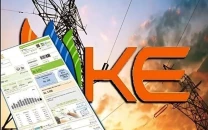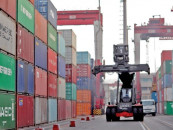Circular debt – a major drag on the energy chain
As govt’s tenure draws to a close, the debt problem aggravates instead of getting better

PHOTO: REUTERS
The previous Pakistan Peoples Party (PPP)-led government, which remained in power from 2008-2013, unsuccessfully made payments of trillions of rupees to tackle the circular debt, but it kept on rearing its ugly head.
When the current Pakistan Muslim League-Nawaz (PML-N) government came to power in June 2013, it cleared Rs480 billion worth of circular debt with the promise that the issue had been resolved once and for all for a smooth functioning of the entire energy chain.
However, as the government is going to complete its five-year term in the next around one month, the situation is worse than that witnessed at the beginning of its tenure. It is going to leave an extremely bad legacy for the upcoming administration.
In February 2018, the circular debt had piled up to Rs534 billion even after payment of Rs53 billion to the independent power producers (IPPs) and oil marketing giant Pakistan State Oil (PSO). In the circular debt, receivables of the power sector have continued to swell.
In actual terms, the circular debt stood at around Rs991 billion which included the Rs510 billion in loans acquired from banks by Power Holding Private Limited (PHPL) to settle the earlier debt.
As the debt solution is nowhere to be seen, the power sector is facing a cash crunch which may add to consumer woes with increase in load-shedding in summer months.
In March this year, PHPL borrowed Rs80 billion to reduce liabilities of PSO and the IPPs, but only Rs53 billion was paid to the IPPs, nuclear power plants and PSO whereas the remaining Rs27 billion was utilised to bear the cost of debt servicing.
The Rs53-billion released by the finance ministry was just peanuts for tackling a huge challenge. The money was just enough to sustain the power sector in March only.
Point to ponder
Multilateral donors such as the International Monetary Fund (IMF) and the World Bank were in agreement that the power sector could perform well if the circular debt was restricted to Rs325 billion. However, the debt was at significantly higher levels, which had made it tough for the government to run the energy chain in a smooth way.
Now, the Ministry of Energy (Power Division) has asked the government to dole out Rs150 to Rs200 billion for operating the power sector efficiently over the next four to five months before the handover of power to the next elected government.
A marked improvement in the recovery of electricity bills can make things better for the energy chain. However, receivables of the power sector had gone beyond Rs805 billion as of January 31, 2018, which had stood at Rs730 billion on June 30, 2017, an increase of over 10% in seven months.
In the receivables, the dues to be paid by the private sector swelled to Rs600 billion from Rs554.8 billion as power distribution companies could not ramp up bill recoveries from the sector.
In the period under review, bill collection by the distribution companies fell 10.3% to Rs655.94 billion as opposed to the recovery of Rs731.71 billion at the end of June 2017.
Receivables from the provinces increased to Rs139.38 billion, which were Rs115 billion on June 30, 2017. Punjab had to pay Rs3.92 billion as collection from the province stood at Rs12.74 billion against bills of Rs14.99 billion.
Receivables from the Khyber-Pakhtunkhwa government amounted to Rs20.22 billion by the end of January 2018 compared to Rs19.65 billion on June 30, 2017. Collection from the province was Rs3.16 billion against bills of Rs3.88 billion.
There had also been an increase in Azad Jammu and Kashmir receivables to Rs91.88 billion compared to Rs80.75 billion.
K-Electric, which provides electricity for Karachi consumers, owed Rs66.79 billion for regularly receiving 650 megawatts of electricity from the national grid as of January 31, 2018 against Rs60.07 billion on June 30, 2017.
The amount due to be paid by Balochistan on account of running agriculture tube wells reached Rs214.25 billion against Rs185.30 billion on June 30, 2017, an increase of 15.6%.
Oil and gas companies
Power is not the only sector that is suffering as the circular debt has plagued the entire energy chain. Pakistan’s largest hydrocarbon exploration firm, Oil and Gas Development Company (OGDC), had to receive Rs292 billion as on April 6 from its clients.
The amount included Rs90 billion on account of late payment surcharge. Its major defaulters were public gas utilities and oil refineries. It also has to pay Rs118 billion to different parties.
Another major company is PSO whose receivables have gone sky high at Rs316 billion despite receiving some payments recently.
The oil marketing giant’s market share has dropped and it is facing financial collapse. Power producers are its primary defaulters as they have to pay Rs266 billion. Apart from them, Sui Northern Gas Pipelines Limited (SNGPL) owes PSO Rs24 billion on account of liquefied natural gas (LNG) supply.
Public gas utilities, in turn, were also reeling from the circular debt. Sui Southern Gas Company (SSGC) has to receive Rs205 billion from its clients including Rs79.3 billion from K-Electric, Rs53 billion from Pakistan Steel Mills, Rs8.89 billion from SNGPL, Rs1.9 billion from the Water and Power Development Authority (Wapda), Rs23.2 billion in sales tax recovery and Rs18.4 billion in income tax recovery.
On the flip side, SSGC has to pay Rs146.7 billion to gas producers which includes Rs69 billion to OGDC, Rs42.6 billion to Pakistan Petroleum Limited and Rs34.9 billion to Government Holdings Private Limited.
Opportunity lost
Though the slump in international crude oil prices had been a blessing for the present government, it could not cash in on the opportunity to erase the circular debt.
It imposed several surcharges - financial cost surcharge, tariff rationalisation surcharge and debt servicing surcharge – which were called ad hoc measures to get rid of the debt, but at the same time it could not improve governance in power distribution companies where employees were engaged in power theft.
In the meantime, the debt has continued to grow and the Power Division has now linked the running of power plants with release of Rs150-200 billion.
Consumers are bracing for prolonged blackouts that negates repeated tall claims of the government that it will end load-shedding at least by the end of its tenure.


















COMMENTS
Comments are moderated and generally will be posted if they are on-topic and not abusive.
For more information, please see our Comments FAQ